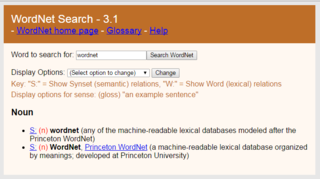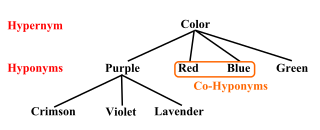
A semantic network, or frame network is a knowledge base that represents semantic relations between concepts in a network. This is often used as a form of knowledge representation. It is a directed or undirected graph consisting of vertices, which represent concepts, and edges, which represent semantic relations between concepts, mapping or connecting semantic fields. A semantic network may be instantiated as, for example, a graph database or a concept map. Typical standardized semantic networks are expressed as semantic triples.

WordNet is a lexical database of semantic relations between words that links words into semantic relations including synonyms, hyponyms, and meronyms. The synonyms are grouped into synsets with short definitions and usage examples. It can thus be seen as a combination and extension of a dictionary and thesaurus. While it is accessible to human users via a web browser, its primary use is in automatic text analysis and artificial intelligence applications. It was first created in the English language and the English WordNet database and software tools have been released under a BSD style license and are freely available for download from that WordNet website. There are now WordNets in more than 200 languages.
Word-sense disambiguation (WSD) is the process of identifying which sense of a word is meant in a sentence or other segment of context. In human language processing and cognition, it is usually subconscious/automatic but can often come to conscious attention when ambiguity impairs clarity of communication, given the pervasive polysemy in natural language. In computational linguistics, it is an open problem that affects other computer-related writing, such as discourse, improving relevance of search engines, anaphora resolution, coherence, and inference.

Hyponymy and hypernymy are semantic relations between a term belonging in a set that is defined by another term and the latter. In other words, the relationship of a subtype (hyponym) and the supertype. The semantic field of the hyponym is included within that of the hypernym. For example, pigeon, crow, and eagle are all hyponyms of bird, their hypernym.
Lexical semantics, as a subfield of linguistic semantics, is the study of word meanings. It includes the study of how words structure their meaning, how they act in grammar and compositionality, and the relationships between the distinct senses and uses of a word.
Readability is the ease with which a reader can understand a written text. In natural language, the readability of text depends on its content and its presentation. Researchers have used various factors to measure readability, such as:
Semantic similarity is a metric defined over a set of documents or terms, where the idea of distance between items is based on the likeness of their meaning or semantic content as opposed to lexicographical similarity. These are mathematical tools used to estimate the strength of the semantic relationship between units of language, concepts or instances, through a numerical description obtained according to the comparison of information supporting their meaning or describing their nature. The term semantic similarity is often confused with semantic relatedness. Semantic relatedness includes any relation between two terms, while semantic similarity only includes "is a" relations. For example, "car" is similar to "bus", but is also related to "road" and "driving".
In linguistics, statistical semantics applies the methods of statistics to the problem of determining the meaning of words or phrases, ideally through unsupervised learning, to a degree of precision at least sufficient for the purpose of information retrieval.

Distributional semantics is a research area that develops and studies theories and methods for quantifying and categorizing semantic similarities between linguistic items based on their distributional properties in large samples of language data. The basic idea of distributional semantics can be summed up in the so-called distributional hypothesis: linguistic items with similar distributions have similar meanings.
Text simplification is an operation used in natural language processing to change, enhance, classify, or otherwise process an existing body of human-readable text so its grammar and structure is greatly simplified while the underlying meaning and information remain the same. Text simplification is an important area of research because of communication needs in an increasingly complex and interconnected world more dominated by science, technology, and new media. But natural human languages pose huge problems because they ordinarily contain large vocabularies and complex constructions that machines, no matter how fast and well-programmed, cannot easily process. However, researchers have discovered that, to reduce linguistic diversity, they can use methods of semantic compression to limit and simplify a set of words used in given texts.
In natural language processing, semantic role labeling is the process that assigns labels to words or phrases in a sentence that indicates their semantic role in the sentence, such as that of an agent, goal, or result.
Lexical substitution is the task of identifying a substitute for a word in the context of a clause. For instance, given the following text: "After the match, replace any remaining fluid deficit to prevent chronic dehydration throughout the tournament", a substitute of game might be given.
SemEval is an ongoing series of evaluations of computational semantic analysis systems; it evolved from the Senseval word sense evaluation series. The evaluations are intended to explore the nature of meaning in language. While meaning is intuitive to humans, transferring those intuitions to computational analysis has proved elusive.
In natural language processing, textual entailment (TE), also known as natural language inference (NLI), is a directional relation between text fragments. The relation holds whenever the truth of one text fragment follows from another text.
In natural language processing, semantic compression is a process of compacting a lexicon used to build a textual document by reducing language heterogeneity, while maintaining text semantics. As a result, the same ideas can be represented using a smaller set of words.

In natural language processing (NLP), a word embedding is a representation of a word. The embedding is used in text analysis. Typically, the representation is a real-valued vector that encodes the meaning of the word in such a way that words that are closer in the vector space are expected to be similar in meaning. Word embeddings can be obtained using language modeling and feature learning techniques, where words or phrases from the vocabulary are mapped to vectors of real numbers.

Word2vec is a technique for natural language processing (NLP) published in 2013. The word2vec algorithm uses a neural network model to learn word associations from a large corpus of text. Once trained, such a model can detect synonymous words or suggest additional words for a partial sentence. As the name implies, word2vec represents each distinct word with a particular list of numbers called a vector. The vectors are chosen carefully such that they capture the semantic and syntactic qualities of words; as such, a simple mathematical function can indicate the level of semantic similarity between the words represented by those vectors.
UBY is a large-scale lexical-semantic resource for natural language processing (NLP) developed at the Ubiquitous Knowledge Processing Lab (UKP) in the department of Computer Science of the Technische Universität Darmstadt . UBY is based on the ISO standard Lexical Markup Framework (LMF) and combines information from several expert-constructed and collaboratively constructed resources for English and German.
Paraphrase or paraphrasing in computational linguistics is the natural language processing task of detecting and generating paraphrases. Applications of paraphrasing are varied including information retrieval, question answering, text summarization, and plagiarism detection. Paraphrasing is also useful in the evaluation of machine translation, as well as semantic parsing and generation of new samples to expand existing corpora.

In natural language processing, a sentence embedding refers to a numeric representation of a sentence in the form of a vector of real numbers which encodes meaningful semantic information.






